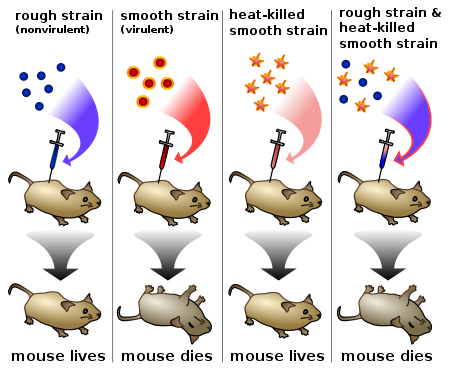Griffith's experiment,[1] performed by Frederick Griffith and reported in 1928,[2] was the first experiment suggesting that bacteria are capable of transferring genetic information through a process known as transformation.[3][4] Griffith's findings were followed by research in the late 1930s and early 40s that isolated DNA as the material that communicated this genetic information.

Pneumonia was a serious cause of death in the wake of the post-WWI Spanish influenza pandemic, and Griffith was studying the possibility of creating a vaccine. Griffith used two strains of pneumococcus (Diplococcus pneumoniae) bacteria which infect mice – a type III-S (smooth) which was virulent, and a type II-R (rough) strain which was nonvirulent. The III-S strain synthesized a polysaccharide capsule that protected itself from the host's immune system, resulting in the death of the host, while the II-R strain did not have that protective capsule and was defeated by the host's immune system. A German bacteriologist, Fred Neufeld, had discovered the three pneumococcal types (Types I, II, and III) and discovered the quellung reaction to identify them in vitro.[5] Until Griffith's experiment, bacteriologists believed that the types were fixed and unchangeable, from one generation to another.
In this experiment, bacteria from the III-S strain were killed by heat, and their remains were added to II-R strain bacteria. While neither alone harmed the mice, the combination was able to kill its host. Griffith was also able to isolate both live II-R and live III-S strains of pneumococcus from the blood of these dead mice. Griffith concluded that the type II-R had been "transformed" into the lethal III-S strain by a "transforming principle" that was somehow part of the dead III-S strain bacteria.
Today, we know that the "transforming principle" Griffith observed was the DNA of the III-s strain bacteria. While the bacteria had been killed, the DNA had survived the heating process and was taken up by the II-R strain bacteria. The III-S strain DNA contains the genes that form the smooth protective polysaccharide capsule. Equipped with this gene, the former II-R strain bacteria were now protected from the host's immune system and could kill the host. The exact nature of the transforming principle (DNA) was verified in the experiments done by Avery, McLeod and McCarty and by Hershey and Chase.
Notes
edit- ^ Experiment. PubPub. doi:10.21428/cdd5dd5a.
- ^ Griffith, Fred. (January 1928). "The Significance of Pneumococcal Types". Journal of Hygiene. 27 (2). Cambridge University Press: 113–159. doi:10.1017/S0022172400031879. JSTOR 4626734. PMC 2167760. PMID 20474956.
- ^ Lorenz, M. G.; Wackernagel, W. (1994-09-01). "Bacterial gene transfer by natural genetic transformation in the environment". Microbiological Reviews. 58 (3): 563–602. doi:10.1128/MMBR.58.3.563-602.1994. PMC 372978. PMID 7968924.
- ^ Downie, A. W. (1972). "Pneumococcal transformation — a backward view: Fourth Griffith Memorial Lecture" (PDF). Journal of General Microbiology. 73 (1): 1–11. doi:10.1099/00221287-73-1-1. PMID 4143929. Archived (PDF) from the original on 2012-03-02. Retrieved 2011-11-30.
- ^ Lehrer, Steven (2006). Lehrer, Steven. Explorers of the Body. 2nd edition 2006 p 44. iUniverse. ISBN 9780595407316.
References
edit- Avery, MacLeod, and McCarty (1944). "Studies on the Chemical Nature of the Substance Inducing Transformation of Pneumococcal Types: Induction of Transformation by a Desoxyribonucleic Acid Fraction Isolated from Pneumococcus Type III". Journal of Experimental Medicine. 79 (1): 137–158. doi:10.1084/jem.79.2.137. PMC 2135445. PMID 19871359.
{{cite journal}}: CS1 maint: multiple names: authors list (link)
- (References the original experiment by Griffith. Original article and 35th anniversary reprint available.)
Further reading
edit- Daniel Hartl; Elizabeth Jones (2005). Genetics: Analysis of Genes and Genomes, 6th edition. Jones & Bartlett. 854 pages. ISBN 0-7637-1511-5
- Lehrer, Steven (2006). Explorers of the Body (2nd ed.). United States: iUniverse, Inc. ISBN 0-595-40731-5.